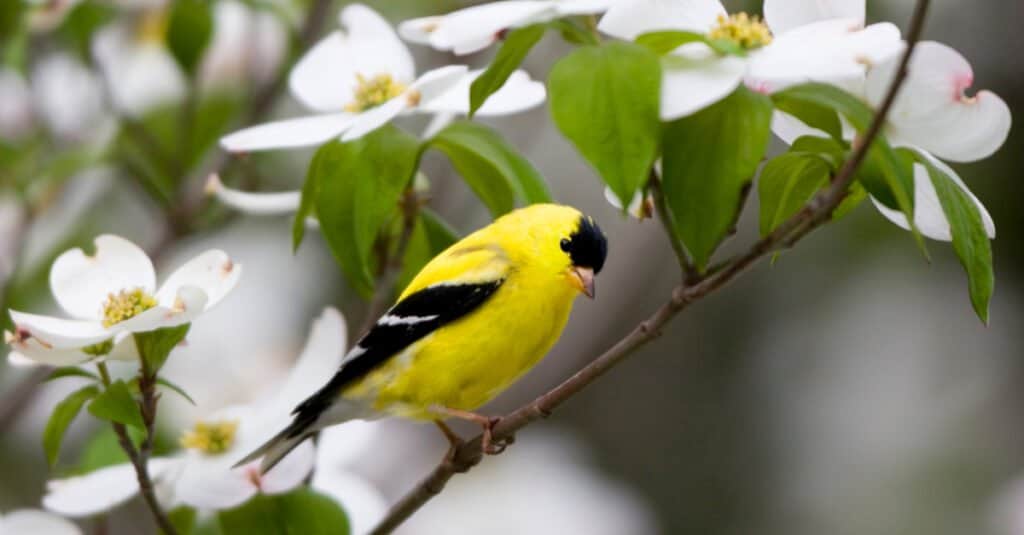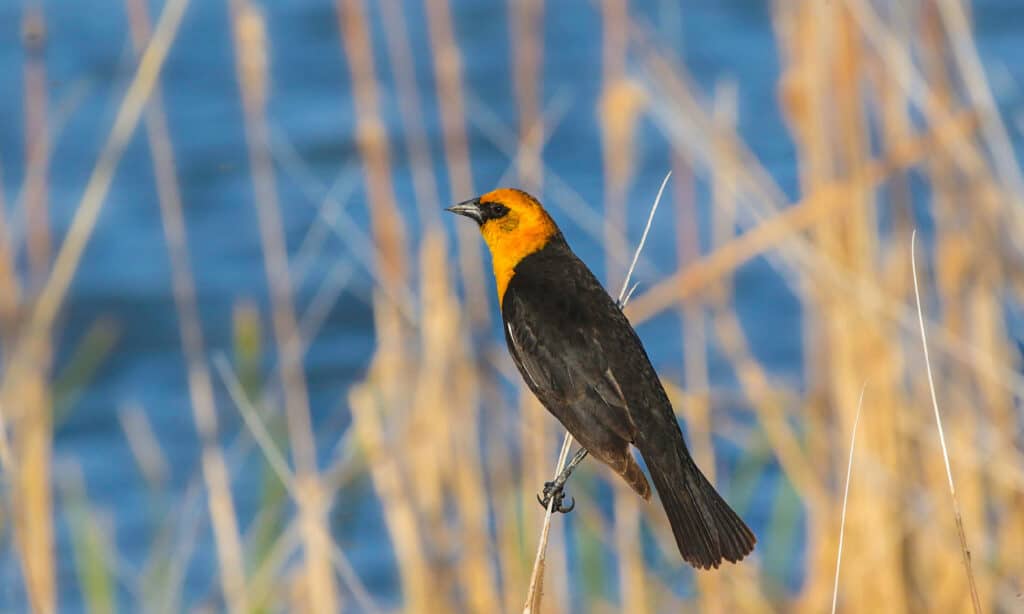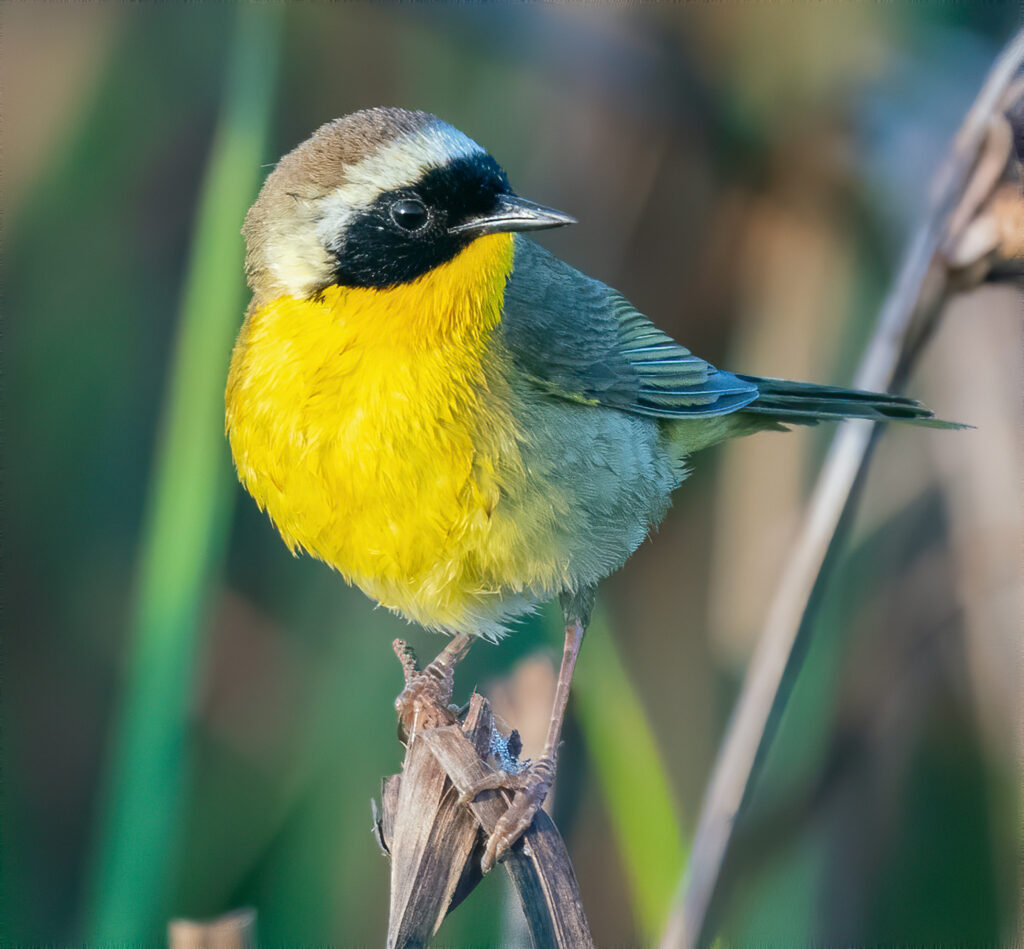The stark contrast between bright yellow and midnight black is eye-catching, especially when it adorns an elegant bird hopping on branches or flitting around bushes. Many bird species feature colorful plumage in North America. Discover 11 beautiful yellow and black birds and learn about their locations, habitats, and behavior.
American Goldfinch

©Danita Delimont/Shutterstock.com
The American goldfinch is common in North America, usually around suburban bird feeders. They breed in Southern Canada and the Northern United States and winter in the southern half of the United States and Mexico. However, there are quite a few year-round residents in the US. This species prefers open weedy areas, like fields, floodplains, parks, and backyards. You can spot them with their bright yellow plumage, black foreheads, and black wings. Their wings also have light white barring.
Yellow-headed Blackbird

©iStock.com/Nancy Strohm
The yellow-headed blackbird is hard to ignore. With their all-black bodies, golden yellow heads, and rusty calls, this is not a species you will easily forget. They are a familiar sight during summers in the Central and Northwestern United States. These short-distance migrants spend winters in the Southwest and Mexico. They breed in wet prairies, mountain meadows, and marshes, nesting in tall cattails near the red-winged blackbird. They form large flocks in the winter to forage in fields, ranches, and farms.
Common Yellowthroat

©DC Wildlife Photography/Shutterstock.com

If you see a vocal little bird with a black face mask hopping through dense tangles, you’ve spotted the common yellowthroat. These birds are olive with bright yellow throats and breasts. And their black eye mask is offset by a blurry white line that separates the face from the head. The common yellowthroat is abundant across North America, breeding in Canada and the US and wintering in Mexico and Central America. However, it is completely absent throughout most of the Southwest. They live in many habitats, such as prairies, pine forests, and wetlands, preferring to skulk through dense, tangled vegetation.
Lesser Goldfinch

©iStock.com/Sunil Singh
The lesser goldfinch is an inhabitant of scrubby habitats of the West. Most populations live permanently along the west coast and the Southwest, while others breed in more northern regions (Colorado, Idaho, etc.) and winter in Mexico. There are also year-round residents in Central and South America. They like patchy, open areas, like thickets, scrubland, weedy fields, and forest clearings. They are about the same size as the American goldfinch but feature duller plumage in some locations near the coast. Males have glossy black plumage above and bright yellow below with black heads.
Scott’s Oriole

©Agami Photo Agency/Shutterstock.com
Scott’s oriole is a vividly contrasting bird of the dry Southwest. They are long and slender with black heads, backs, wings, and chests, and yellow undersides. They also have white barring on their wings. This species spends its springs and summers in the Southwestern United States and winters in Mexico. They live in arid mountains, foothills, and deserts, where their bright yellow feathers stand out against the stark neutral background. Scott’s oriole is often associated with yucca, where it forages and weaves its nests.
Eastern Meadowlark

©iStock.com/passion4nature
Many black and white birds live in the west, but the eastern meadowlark adorns grasslands and farms throughout most of the eastern half of the United States. They stay in their environments year-round, except for the very northern populations that move south for winter. You can find them in prairies, pastures, grasslands, and fields, where they stalk thick vegetation and nest on the ground. You can identify them by their streaky buff, black, and reddish-brown upperparts and bright yellow underparts. They also have very distinctive black V shapes across their chests.
Evening Grosbeak

©Danita Delimont/Shutterstock.com
The evening grosbeak is a wintering bird throughout most of the United States. They add splashes of bright color to winter backgrounds. Some populations, especially those in the Northwest and Canada, stay permanently in their environments. They inhabit mature coniferous forests but will also stop by urban and suburban areas. These large finches have thick, conical bills and a mix of gray, black, white, and yellow plumage. Look for their prominent white wing patches and yellow stripes above their eyes.
Hooded Warbler

©Agami Photo Agency/Shutterstock.com
The hooded warbler is easy to identify with its olive-yellow and gray plumage and yellow faces with black hoods and throats. This bird breeds in eastern forests in the United States and migrates across the Gulf of Mexico before reaching its wintering grounds in Central America. They live in the dense understory of mature deciduous forests. You can also find them in lowland tropical forests in Central and South America.
Prairie Warbler

©Jay Gao/Shutterstock.com
Look for the streaky yellow prairie warbler in scrubby forests of the Southeastern US. After spending their summers in the hot, humid Southeast, they make their way to the West Indies for the winter. However, there are permanent residents in Florida. They live in the open canopies of shrubby, second-growth forests, except for the Florida subspecies, which inhabit mangrove forests. Males are bright yellow with heavy black streaking and chestnut patches on their backs. They also have black half-circles under their eyes. They are small warblers with thing bills and long, slender tails.
Western Tanager

©Laura Mountainspring/Shutterstock.com
Western tanagers look like flashes of orange and yellow flames as they flit around open woods. You will find this species in the western half of the United States and Canada during spring and summer and in Mexico and Central America during winter. Listen for their low chuckles in open coniferous woodlands, where they like to stay hidden in the canopy. However, when you do spot one they are unmistakable. Look for their bright orange faces, yellow bodies, and black wings.
Wilson’s Warbler

©iStock.com/Leon Gin
The Wilson’s warbler is another black and yellow bird that’s easy to identify. They have yellow bodies, streaky gray wings, and prominent black caps, giving them the appearance of having a perfect patch of black hair on their heads. They breed in Canada and migrate throughout the United States before reaching their wintering spot in Mexico and Central America. You will find these birds in willow and shrubby thickets and forest edges or openings. They may even inhabit high-elevation cloud forests in their wintering habitats.



